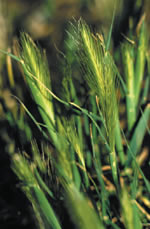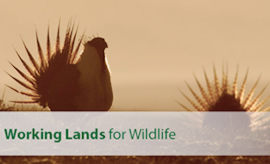[wp-rss-aggregator feeds=”usda-latest-news-releases”]

A plant species that establishes itself in a previously barren environment, QuickGuard provides solutions for erosion control, allowing growing time for perennial plant establishment.
Seeding with fast germinating species may be the best means of stabilizing soils under certain conditions.
Hybrid species developed to be a more perfect cover crop: fast germinating with over 90% cytoplasmic sterility so that they will not compete with the more desirable native plants. Sterile Triticale Hybrid, known as QuickGuard, is one of the best cover crops available.
QuickGuard got its name for its ability to germinate rapidly. It is considered the most tolerable hybrid plant out there that can withstand harsh conditions, and is an excellent choice when it comes to barren environments.
More specifically, QuickGuard is an annual cereal grain that establishes itself in a previously barren environment. It is excellent for stabilizing disturbed areas since it adapts to a wide range of soils and helps build organic matter. It is a great solution for erosion control, and allows growing time for perennial plant establishment in even the harshest conditions.
There’s a reason QuickGuard is considered the most tolerable plant — it’s even drought and disease tolerant. This plant does well in semi-arid regions in the western United States like Utah.
QuickGuard is hardy and durable, but not persistent or invasive. Adaptable to either spring or fall planting, it is cold tolerant, with good winter survival, and drought tolerant as well. In studies by the National Research Council of the National Academy of Sciences, QuickGuard performs better than wheat on a wide range of soil conditions: dry and sandy soils, infertile soils, acid and alkaline soils, cold soils and mineral deficient or high boron soils. QuickGuard develops a dense fibrous root system and upright growth habit to stabilize soils while allowing desirable perennial species to establish.
If you’ve ever been on a cross-country road trip, there’s a chance that you’ve passed large pieces of land that look dry and desolate. If so, the odds are that there are plans to introduce something called QuickGuard.
When you hear the term “QuickGuard,” you might not think of a plant. It sounds more like a type of fertilizer or protectant. QuickGuard is actually considered a cover crop, which is an unharvested crop that is part of a planned rotation to provide benefits to the soil. It is exceptionally hardy and beneficial to whichever environment it is introduced.
QuickGuard is perfect for short-term soil stabilization on erosion control projects in semi-arid regions. Often, it serves well as a soil stabilizer and short-term cover crop. You can use it alone or as a nurse plant with slower establishing perennials, but is also excellent for mining reclamation, road development, new construction, and fixing soil disturbance.
QuickGuard performs better than wheat on a wide range of soil conditions: dry and sandy soils, infertile soils, acid and alkaline soils, cold soils and mineral deficient or high boron soils.
According to the United States Department of Agriculture, there are four basic principles for improving soil health:
Under these principles, QuickGuard is considered an adequate cover crop with loads of benefits. Cover crops help create fulfilling ecosystems, build organic matter, prevent soil erosion and promote aeration, and increases nutrient cycling and usage.
Cover crops feed many types of soil organisms. Soil fungi and bacteria feed on the carbohydrates that plants release through their roots, which in turn gives the plants essential nutrients like nitrogen and phosphorus. Arthropods and worms feed on the fungi and bacteria, thus creating a fulfilling ecosystem.
Cover crops are like all other plants in the sense that they need sunlight and carbon dioxide to make carbon-based molecules, which causes a buildup of carbon within the soil. Some leftover carbon becomes humic substances, which helps build soil organic matter. A higher level of this matter improves the nutrients and moisture for the crops.
Thanks to wind and rain, soil erosion is a widespread phenomenon. Although this is natural, it’s not always a good thing to happen. When soil erosion occurs, the topsoil blows over and exposes the underneath to the bare sun — which becomes hot enough to kill organisms, thus stressing out the plants. Cover crops like QuickGuard can protect the soil from getting too hot if soil erosion occurs.
Aeration is the process of introducing air into the ground, which can be difficult if there’s too much excess rain in the soil — a phenomenon which none of us can control. Luckily, cover crops help produce natural aeration that directly benefit the soil and all of its organisms.
Cover crops also attract earthworms, which is one of the most noticeable organisms you might see in any soil. Earthworms can tunnel vertically and horizontally, which creates channels for rain and air to move through freely and effectively.
Erosion control is the practice of controlling erosion in agriculture, land development, and construction. Effectively using erosion control methods are necessary for preventing water pollution, soil loss, habitat loss, and property loss.
You might be wondering how QuickGuard plays a role in erosion control. Thanks to its durability, QuickGuard can be planted in dusty areas where the topsoil is easily carried away by the wind. It can also root on slopes, which absorbs wind and water that erodes topsoil.
Soil stabilization is the process to change the physical properties of soil to improve its strength and durability. Healthy, stabilized soil will be more resistant to being damaged by inclement conditions.
QuickGuard is a top choice for stabilizing disturbed areas because it’s hardy and reliable. It germinates quickly and can adapt to almost any type of soil without a problem. It also improves nutrient use among living organisms, which directly benefits the crops again in return.

USDA announces $40 million available to help ranchers restore sage grouse habitat. Click here to be taken to the USDA’s webpage for more information.
Attention Private Landowners! Usda Makes Funds Available For Sage Grouse Habitat RestorationContact us our experts are available to help with your reclamation, erosion control, turf and native seed projects.
CONTACT US